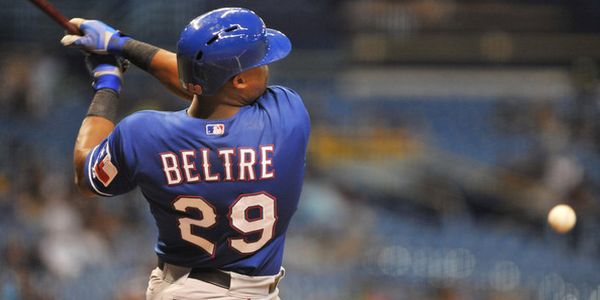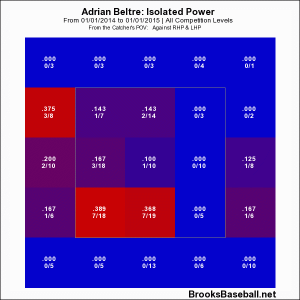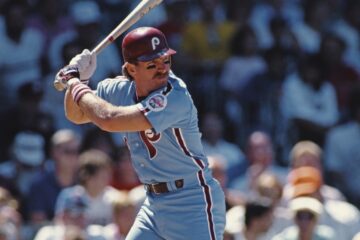2014 Fantasy Baseball: Adrian Beltre and Getting Old

Getting old, it happens. This Sunday, I became another year older, giving me 12 months before I’m represented by a number that begins with a three. We try not to lose it, but soon our prime only becomes a memory. I suppose it’s better than the alternative, despite what Debbie says.
In baseball, a player’s mid-thirties are seen as the days of deterioration. So what third baseman Adrian Beltre has done for the past several seasons is highly impressive. He has not only been one of the best at his position, but one of the best in baseball. Since 2010, only five players have put up a higher WAR. They also all happen to be younger. And with each passing birthday, Beltre gets closer and closer to the inevitable fall.
As of Sunday, June 1st, Beltre showed some struggles with zone contact percentage and power. On a day I got older, was Beltre getting old?
| Season | Team | Strikeout% | Z-Contact% | .ISO |
| 2009 | Mariners | 15.5% | 84.4% | .144 |
| 2010 | Red Sox | 12.8% | 89.1% | .233 |
| 2011 | Rangers | 10.1% | 91.4% | .265 |
| 2012 | Rangers | 12.5% | 89.3% | .240 |
| 2013 | Rangers | 11.3% | 90.2% | .193 |
| 2014 | Rangers | 15.5% | 86.0% | .152 |
| Total | – – – | 14.7% | 88.1% | .195 |
The decline in zone contact percentage is somewhat alarming. Bill Petti has done some nice work looking into what this sort of drop could mean:
Besides [Josh] Hamilton, we also see two-thirds of the Braves outfield appear on the list, as Jason Heyward and B.J. Upton saw their Z-Contact% decline by 4.7% an 4.3% respectively.
Based on my original research, 34% of hitters who saw similar declines in Z-Contact% experienced a wOBA decline of at least .30 points the following year. To some extent then, it appears that Z-Contact% could be a decent signal of trouble in hitters.
Right now, Beltre has about a four percent drop in his Z-Contact% when compared to 2013.
The next sets of numbers throughout this article do not include June 4th’s game.
Beltre’s wOBA:
| Season | Team | wOBA |
| 2009 | Mariners | .301 |
| 2010 | Red Sox | .391 |
| 2011 | Rangers | .381 |
| 2012 | Rangers | .388 |
| 2013 | Rangers | .379 |
| 2014 | Rangers | .364 |
Looks like there is a potential trend developing. However, most hitters would love to have that 2014 wOBA, as it is well above league average. Let’s not get into a panic just yet.
| Season | Team | GB/FB | LD% | GB% | FB% | IFFB% | HR/FB |
| 2011 | Rangers | 0.86 | 18.1 % | 37.8 % | 44.1 % | 10.8 % | 16.4 % |
| 2012 | Rangers | 0.98 | 21.1 % | 39.0 % | 39.9 % | 10.4 % | 17.0 % |
| 2013 | Rangers | 0.95 | 21.8 % | 38.2 % | 40.0 % | 7.2 % | 13.5 % |
| 2014 | Rangers | 1.20 | 23.4 % | 41.8 % | 34.8 % | 0.0 % | 12.2 % |
| Total | – – – | 1.03 | 19.5 % | 40.9 % | 39.6 % | 10.7 % | 13.8 % |
Zero infield fly balls is extremely impressive. That won’t last all season, but maybe that tells us Beltre’s swing isn’t out of whack. The 35% fly ball rate is currently below league average and almost five percent lower than his usual output. That isn’t going to help his home run total.
| Season | O-Swing% | Z-Swing% | Swing% | O-Contact% | Z-Contact% | Contact% | Zone% | SwStr% |
| 2011 | 36.4 % | 65.7 % | 50.7 % | 74.0% | 91.4% | 85.0% | 48.8% | 7.6 |
| 2012 | 38.1 % | 66.2 % | 51.6 % | 73.6% | 89.3% | 83.3% | 48.0% | 8.5 |
| 2013 | 35.2 % | 64.2 % | 48.9 % | 77.5% | 90.2% | 85.4% | 47.3% | 6.8 |
| 2014 | 35.3 % | 64.7 % | 49.4 % | 81.5% | 86.2% | 84.5% | 47.8% | 7.6 |
| Total | 37.1 % | 65.7 % | 50.9 % | 72.1% | 88.1% | 82.1% | 48.3% | 9.7 |
Maybe Beltre should stop being so good at making outside contact (about 70% is league average). Victor Martinez (87%) tops the majors in outside contact percentage and Beltre is seventh on that same list.
It is doing his power no favors.
Beltre entered Tuesday’s game with five home runs. After Wednesday’s game, he ended with eight. The two-game outburst that saw him go five for eight at the plate with no strikeouts and three bombs. Is he getting back on track? But what about the three-year decline in .ISO and the four-year decline in wOBA? What about the increase in strikeouts and decrease of contact in the zone? Beltre also suffered a strain quadriceps earlier in the year and many of his injuries have been related to his legs. His odds of staying healthy is a lesser compared to the average player. Does this all add up to a hitter losing his elite value? Should we ignore the sudden two-game surge? At age-35, can anyone rationally say Beltre is becoming a better player?
When you look at Beltre’s overall profile, there isn’t too much to get worked up about. Is the power in decline? That seems fair to say. Is he at his peak? Obviously not. But this shouldn’t be surprising to hear when talking about a 35-year-old baseball player. The decline in zone contact percentage is worth noting. If that continues to hold or worsen throughout the entire year, you may want to think twice about drafting the 36-year-old version of Beltre next season, especially if it comes with a high price tag. Until then, there is more reason to believe than not that Beltre can deliver a healthy batting average with about 25 home runs in 2014. He is still a very good hitter. However, his days of hitting .315 with 30-plus bombs could be over. Maybe you expected more. Maybe the Rangers expected more. Maybe Adrian Beltre expected more.
Maybe I expected more. What a drag it is getting old.







2 Comments
Good work Rich. Just wait until the big number in front is a four.
Thanks Scott.
I will try to take my time getting there.